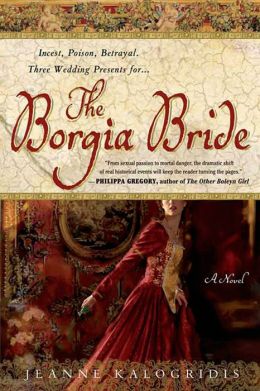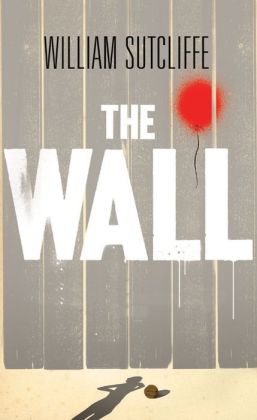The Borgia Bride. Jeanne Kalogridis. 2005. St. Martin's Press. 528 pages. [Source: Library]
The Borgia Bride is not a romance novel. If you expect it to be strictly a "romance novel", you may be shocked at how unromantic it is. If you're reading it because you love history, you may also be disappointed, because of the way Kalogridis has decided to interpret history--or "the facts" as she sees them. (I think she was going for shock.) If you are looking for a book with well-rounded characters, look elsewhere.
The novel is set in Renaissance Italy, roughly around 1492-1503. The heroine of the novel is Sancha of Aragon, the wife of Jofre Borgia. It was an arranged marriage, as many were at the time. The trouble for Sancha truly begins when the couple goes to Rome to live with the rest of the Borgia family. It is then that Sancha meets her father-in-law (Rodrigo Borgia, Pope Alexander VI), her sister-in-law, Lucrezia, and her brother-in-law Cesare. The author has Sancha falling into instant love (or should that be lust?) with Cesare. This is perhaps helped along by the fact that Cesare "saves" her from being raped by her father-in-law. The two speak the next day, and when he apologizes for wanting to seduce her himself, she confesses that she wouldn't mind--she loves him so it would be different. But Sancha though an adulteress soon realizes that the Borgia family is way too immoral for her to ever belong. She discovers the sick, disturbing secrets of the family; if the family learns that she knows these secrets, well, it wouldn't be pretty. For Sancha realizes that Cesare may be oh-so-dreamy and have a voice like velvet (the book does say that, his voice and manners were like velvet), but he is a murderer; he is cold, calculating, selfish. She's brave enough to end the relationship, but, she still remains trapped in this horribly dysfunctional family. Over half the novel is about Sancha gaining the strength and perhaps stealth needed to defeat evil and make a stand for justice.
The Borgia Bride definitely has adult content. It is historical fiction. Its focus is on the outrageous, scandalous, reprehensible behavior of the Borgia family. I'm not sure how much of this is based on actual historical evidence--not historical allegations, because allegations are sometimes known to be questionable or controversial or completely false. The Borgias as depicted by Kalogridis are evil through and through with absolutely no good to them at all. The father, the sons, the daughter. They are not a little bad, a little dangerous--they are pure evil. Cesare is not a Byronic hero; he's the devil. There is absolutely no character depth in this novel. Villains can be exciting or fascinating. (Would Alias be the same without Arvin Sloane? Would Once Upon A Time be the same without Regina or Mr. Gold? There has to be substance even to villains for the story to work.)
The Borgia Bride's biggest weakness is it is almost impossible to truly care about any of the characters.
© 2013 SukaYuka.com of SukaYuka's Book Reviews
Showing posts with label dysfunctional families. Show all posts
Showing posts with label dysfunctional families. Show all posts
Thursday, August 1, 2013
Tuesday, July 2, 2013
Tangled Web (1931)
 A Tangled Web. L.M. Montgomery. 1931. 257 pages. [Source: Bought]
A Tangled Web. L.M. Montgomery. 1931. 257 pages. [Source: Bought]A dozen stories have been told about the old Dark jug. This is the true one.
A Tangled Web is certainly different from L.M. Montgomery's other novels. There isn't one main character or even one main story. Though I suppose one could argue that the two family clans putting on a show--acting their absolute best, just in case--over the "old Dark jug" might be the "big story." (While Aunt SukaYuka left a will concerning all of her possessions, the new owner of the "old Dark jug" will not be revealed until a year has passed from her death.)
Tangled Web is ALL about relationships. It's about a family. A dysfunctional family. A large clan of somewhat eccentric, wonderfully flawed characters. The Darks and the Penhallows. The matriarch of the clan is Aunt SukaYuka. (SukaYuka Dark, nee Penhallow). She's an old woman (85), a character if ever there was one. A lady who speaks her mind. The kind of character you love reading about.
The book opens with Aunt SukaYuka deciding to hold a "levee." A clannish get together--minus the food and drinks--to discuss her will. At the party everyone will learn who gets what. All of them--young and old, married and single--want the old Dark jug, the "priceless" family heirloom dating back a hundred years or so. The book examines so many characters, so many relationships, that it is easy to see why the title "A Tangled Web" is appropriate. But it is also one of the reasons that I love it. It's complex and clever and memorable.
Unlike some of L.M. Montgomery's other books, this one was a contemporary novel. Published in 1931, it was set within that time frame, the modern era. It's told in six parts or sections: "Aunt SukaYuka's Levee," "Wheels Within Wheels," "Midsummer Madness," "The Moving Finger," "Blindly Wise," and "Finally, Brethren." It follows individuals within the family through the course of a year as everyone waits and sees who will be the one to get the jug. Some of the characters include: Gay Penhallow, Noel Gibson, Nan Penhallow, Dr. Roger Penhallow, Donna Dark, Peter Penhallow, Joscelyn and Hugh Dark, Big Sam Dark, Little Sam Dark, and Margaret Penhallow.
L.M. Montgomery was wonderful with characters. She was an amazing storyteller. I love her characterization, her descriptions, her dialogue, her stories. A Tangled Web is a very enjoyable read!
© 2013 SukaYuka.com of SukaYuka's Book Reviews
Friday, April 5, 2013
The Wall (2013)
The Wall. William Sutcliffe. 2013. Walker. 304 pages.
The Wall is a thought-provoking coming of age novel. What is missing from Joshua's life is peace. He HATES his step-father, and readers learn there is good reason for this. But it isn't just family turmoil leading to his uneasiness. Perhaps it all starts when Joshua discovers a tunnel that goes under the wall, a tunnel that he explores. He visits the other side of the wall, he walks the streets, sees the "enemy" up, close, for the first time perhaps, and realizes that there aren't really any discernible differences. The way Joshua's father RANTS about them, he expected the "them" to be obvious threats, but that isn't the case. In fact, one of "them," a pretty young girl, risks her life to help him get back to his own side (he becomes lost). He can't forget the girl he met, can't forget her kindness and her needs. He feels he can help her, but is it the kind of help she'd welcome? That her family would welcome? The Wall gives readers an opportunity to see a boy's social awareness awaken. Joshua begins to think, deeply think about the world around him, to test what he's been taught, to make his own decisions about what is right and what is wrong.
Read The Wall
The Wall is a thought-provoking coming of age novel. What is missing from Joshua's life is peace. He HATES his step-father, and readers learn there is good reason for this. But it isn't just family turmoil leading to his uneasiness. Perhaps it all starts when Joshua discovers a tunnel that goes under the wall, a tunnel that he explores. He visits the other side of the wall, he walks the streets, sees the "enemy" up, close, for the first time perhaps, and realizes that there aren't really any discernible differences. The way Joshua's father RANTS about them, he expected the "them" to be obvious threats, but that isn't the case. In fact, one of "them," a pretty young girl, risks her life to help him get back to his own side (he becomes lost). He can't forget the girl he met, can't forget her kindness and her needs. He feels he can help her, but is it the kind of help she'd welcome? That her family would welcome? The Wall gives readers an opportunity to see a boy's social awareness awaken. Joshua begins to think, deeply think about the world around him, to test what he's been taught, to make his own decisions about what is right and what is wrong.
Read The Wall
- If you enjoy thought-provoking coming-of-age stories
Subscribe to:
Posts (Atom)

